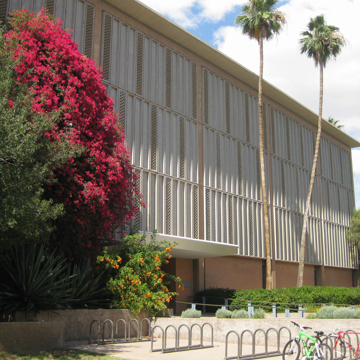You are here
Farmer Education Building
The Farmer Education Building, named in honor of Tempe Normal School’s first headmaster (Hiram Bradford Farmer), was part of the building boom that followed Arizona State’s attainment of university status in 1958. It was designed and built concurrently with Ralph Haver’s Social Sciences Building. The two are conceptual twins, featuring classroom and office spaces organized around a central atrium. The symmetrical building houses 95,578 square feet and is completely modular, using a precast concrete panelized skin with integral sunscreens. Brick is employed contextually at ground level for its association with other campus structures.
Formally dedicated February 8, 1962, Farmer now houses the Mary Lou Fulton Teachers College, a fitting tribute to ASU’s roots in teacher preparation.
References
Elmore, James, ed. Guide to the Architecture of Metro Phoenix. Phoenix: American Institute of Architects, Central Arizona Chapter, 1983.
Olive, Michael B. “ASU Tempe Campus Buildings Survey, 1960-2007.” Master’s thesis, Barrett Honors College, Arizona State University, 2007.
Sydnor, Douglas B. “25 Year Award Nomination.” Phoenix: AIA Arizona, 2010.
Writing Credits
If SAH Archipedia has been useful to you, please consider supporting it.
SAH Archipedia tells the story of the United States through its buildings, landscapes, and cities. This freely available resource empowers the public with authoritative knowledge that deepens their understanding and appreciation of the built environment. But the Society of Architectural Historians, which created SAH Archipedia with University of Virginia Press, needs your support to maintain the high-caliber research, writing, photography, cartography, editing, design, and programming that make SAH Archipedia a trusted online resource available to all who value the history of place, heritage tourism, and learning.










